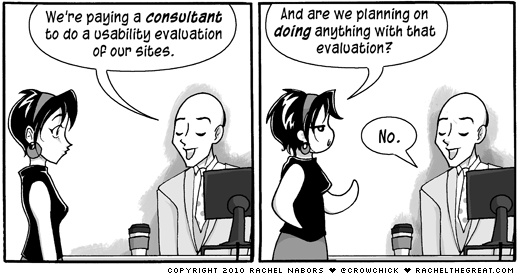Large companies are the financial backbone of the web industry, but their size and complex organizational structure can make them challenging to work with. Having worked on both sides of the fence, I’ve seen great ideas become the casualties of this struggle between the proverbial David and Goliath, as agencies or freelancers meet face to face with Big Business to create web sites. Closing the door to large companies means missing out on important revenue, good work, and more people using our designs, so how can we make large companies work for us?
While working as the UX guy for Telewest Broadband (now Virgin Media), I learned a valuable lesson about working with large companies. I was tasked with improving the experience for their 1.5 million digital TV customers, and having researched and understood where improvements needed to happen—and after spending many days with engineers on install visits to customers’ homes—I was surprised at how reticent some people were to making changes that were easily justified. It was only after conducting interviews with key people across the company that a theme emerged.
Everybody interviewed recognized the need to change, but many feared the change itself. I have since found this fear in other large companies, where change is viewed negatively because of the scale of its impact and the difficulty in doing it without hitches. Often, this reluctance to change is founded in previous disasters. Since identifying this fear, I have done some of my best work for large companies, but it requires a different approach.
What follows, in two parts, are lessons learned that can help make large companies work for us:
- Part 1 — Getting off on the right foot
- Part 2 — Collaborating and avoiding common pitfalls.
The beginning of a relationship or a new project with a large company can be daunting due to their size and complexity. Here are key things to get right up front, staring with the pitch or bid process:
To pitch or not to pitch—that is the question.
The pitch process can be a poor way to start a relationship, particularly with large companies. This process can debilitate the people who design web sites. The companies we pitch to hold all the trump cards, which is why more and more agencies are avoiding pitches altogether. Pitches can be unfair, are sometimes political, and are often judged on visual design by people who are not designers. Pitches can result in a seismic shift in design authority away from designers, unless the designers are willing to stand up, be transparent, and potentially forfeit the work for telling it like it is, as Kevin Mattice puts it in The Clear War. Agencies have been known to overcommit on a design idea and costs in order to win the work, which can prove costly later. All in all, this can be a very poor start to a relationship. There is little evidence to show that the pitch process results in better web sites. In my experience, this process may actually result in poorer sites, because too much say on matters of design are given to the large companies.

Illustration provided by Rachel Nabors
However, for many new or relatively unknown agencies, winning pitches is the way to make a name and get work. Some large companies’ procurement processes dictate that they send work to tender, resulting in pitches. When pitches still play an important role in the agencies’ new business strategies, the question to ask is, to pitch or not to pitch? Winning the wrong pitch can be a great loss, so how do we ensure that what the pitch is worthwhile?
Obviously, just because you are asked to pitch does not mean you should. Some companies can be on the hunt for ideas, or might be using the pitch as a way of gathering comparable prices, which they then use to bash their incumbent agency with. Here are some questions to ask up front, which will help decide if you should pitch:
- Are agencies paid to pitch?
- What is the budget for the project, and has it been approved?
- What other agencies are pitching?
- Can you do your best work on this project?
- Does the pitch sound straightforward?
- Is it communicated well?
- Is the client difficult to deal with?
- What is the process for selection and feedback on the outcome?
For some agencies and freelancers, pitches play an important part in getting work. Before you pitch, ensure that the pitch is one you can afford to win.
For more information, read Getting to no, by Greg Hoy. We spend all our time trying to get to yes with clients, forgetting that sometimes getting to no is just as important. For more on calculating cost and pitch discussions, read Calculating Hours and Pre Bid Discussions, by Andy Rutledge.
Understand the objectives for the site
Clients, like most humans, are quick to jump to solutions to design questions. Aim to guide initial conversations away from what the client says they need and toward the objectives the site needs to meet. If these objectives are not clear, then the right people from the company may not have been involved. Start by clearly identifying the key decision maker for the site, then check again, but this time follow the money to see who’s footing the bill. Sometimes the bill payer and decision maker are the same person, but often in large companies, the bill payer sits up a level or two. There is no better person to tell you what the objectives of a site are than the person paying for it.
Gather disparate views upfront
In addition to the person paying for the design of the site, conduct interviews with other senior people in order to avoid dissenting voices later. These interviews are called stakeholder interviews, and they are one-on-one interviews with all the senior business stakeholders in the site. The aim of these interviews is to get a deeper understanding of the complexity of the environment the site needs to fit within. Stakeholder interviews are a great way of understanding disparate views.
For more on stakeholder interviews, read Understanding Organizational Stakeholders for Design Success, by Jonathan Boutlele and Setting Up Business Stakeholder Interviews, Part 1, by Michael Beavers.
Retain design authority
Left to ourselves, designing sites would be straightforward, but clients—particularly large ones—often impose their design ideas on the project before design starts. Don’t be limited to a preconceived idea on the part of the client, as they make poor designers. Listen carefully to clients and gather their requirements, but always retain total authority over the design.
The following checklist will help you get started on the right foot:
- Ensure that the client is right for you.
- Is the pitch one you can afford to win?
- Never work for free, as your work will be undervalued. Free work also undermines what we do.
- Clearly understand the client’s objectives for the site.
- Interview key people upfront to avoid dissenting voices later.
- Retain design authority at all times.
Check out Part 2 of Collaboration with Large Companies
About the Author

Alan Colville is a user experience designer and founding member of Analog. Having worked on the Web since 1996, his former clients include BlackBerry, Vodafone and Visa. Alan resides in Bristol, England with three women, two of whom are his daughters, making him significantly outnumbered on a daily basis. Alan writes about design and other issues on Twitter and on his own blog, alancolville.org.